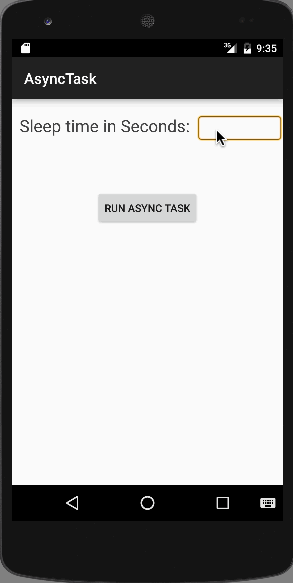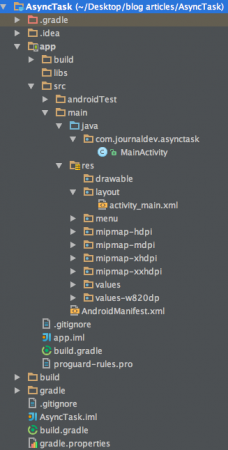今天,我们将研究Android AsyncTask。我们将开发一个在后台执行抽象AsyncTask的Android示例应用程序。
Android AsyncTask
Android AsyncTask是Android提供的一个抽象类,它允许我们自由地在后台执行繁重的任务,并使UI线程保持轻量级,从而使应用程序更具响应性。启动时,Android应用程序在单线程上运行。由于这种单线程模型,获取响应所需的时间较长的任务可能会使应用程序无响应。为了避免这种情况,我们使用Android AsyncTask在后台的专用线程上执行繁重的任务,并将结果传递回UI线程。因此,在Android应用程序中使用AsyncTask使UI线程始终保持响应。Android AsyncTask类中使用的基本方法定义如下:
- doInBackround() :该方法包含需要在后台执行的代码。在此方法中,我们可以通过PublishProgress()方法将结果多次发送到UI线程。要通知后台处理已经完成,我们只需使用Return语句
- onPreExecute() :该方法包含后台处理开始前执行的代码
- onPostExecute() :在doInBackround方法完成处理后调用该方法。来自doInBackround的结果被传递给此方法
- onProgressUpdate() :该方法接收doInBackround方法的进度更新,该方法通过PublishProgress方法发布,该方法可以使用该进度更新来更新UI线程
在android AsyncTask类中使用的三种泛型类型如下所示:
- parms :执行时发送给任务的参数类型
- 进度 :后台计算时发布的进度单位类型
- 结果 :后台计算结果类型
Android异步任务示例
若要启动AsyncTask,MainActivity类中必须存在以下代码段:
1MyTask myTask = new MyTask();
2myTask.execute();
在上面的代码片段中,我们使用了扩展AsyncTask的示例类名,并使用Execute方法启动后台线程。注:
- 必须在UI线程中创建和调用AsyncTask实例。
- 永远不应调用在AsyncTask类中被覆盖的方法。它们是自动调用的
- AsyncTask只能调用一次。再次执行它将引发异常
在本教程中,我们将实现一个AsyncTask,它使进程在用户设置的给定时间段内进入睡眠状态。
Android异步任务项目结构
Android AsyncTask示例代码
XML布局在active_main.xml中定义,其给定如下:active_main.xml
1<RelativeLayout xmlns:android="https://schemas.android.com/apk/res/android"
2 xmlns:tools="https://schemas.android.com/tools"
3 android:layout_width="match_parent"
4 android:layout_height="match_parent"
5 tools:context=".MainActivity" >
6
7 <TextView
8 android:id="@+id/tv_time"
9 android:layout_width="wrap_content"
10 android:layout_height="wrap_content"
11 android:textSize="10pt"
12 android:textColor="#444444"
13 android:layout_alignParentLeft="true"
14 android:layout_marginRight="9dip"
15 android:layout_marginTop="20dip"
16 android:layout_marginLeft="10dip"
17 android:text="Sleep time in Seconds:"/>
18 <EditText
19 android:id="@+id/in_time"
20 android:layout_width="150dip"
21 android:layout_height="wrap_content"
22 android:background="@android:drawable/editbox_background"
23 android:layout_toRightOf="@id/tv_time"
24 android:layout_alignTop="@id/tv_time"
25 android:inputType="number"
26 />
27 <Button
28 android:id="@+id/btn_run"
29 android:layout_width="wrap_content"
30 android:layout_height="wrap_content"
31 android:text="Run Async task"
32 android:layout_below="@+id/in_time"
33 android:layout_centerHorizontal="true"
34 android:layout_marginTop="64dp" />
35 <TextView
36 android:id="@+id/tv_result"
37 android:layout_width="wrap_content"
38 android:layout_height="wrap_content"
39 android:textSize="7pt"
40 android:layout_below="@+id/btn_run"
41 android:layout_centerHorizontal="true" />
42</RelativeLayout>
在上面的布局中,我们使用一个预定义的可绘制对象作为EditText的边框。MainActivity.java的定义如下:
1package com.journaldev.asynctask;
2
3import android.app.ProgressDialog;
4import android.os.AsyncTask;
5import android.os.Bundle;
6import android.support.v7.app.AppCompatActivity;
7import android.view.View;
8import android.widget.Button;
9import android.widget.EditText;
10import android.widget.TextView;
11
12public class MainActivity extends AppCompatActivity {
13 private Button button;
14 private EditText time;
15 private TextView finalResult;
16
17 @Override
18 protected void onCreate(Bundle savedInstanceState) {
19 super.onCreate(savedInstanceState);
20 setContentView(R.layout.activity_main);
21 time = (EditText) findViewById(R.id.in_time);
22 button = (Button) findViewById(R.id.btn_run);
23 finalResult = (TextView) findViewById(R.id.tv_result);
24 button.setOnClickListener(new View.OnClickListener() {
25 @Override
26 public void onClick(View v) {
27 AsyncTaskRunner runner = new AsyncTaskRunner();
28 String sleepTime = time.getText().toString();
29 runner.execute(sleepTime);
30 }
31 });
32 }
33
34 private class AsyncTaskRunner extends AsyncTask<String, String, String> {
35
36 private String resp;
37 ProgressDialog progressDialog;
38
39 @Override
40 protected String doInBackground(String... params) {
41 publishProgress("Sleeping..."); // Calls onProgressUpdate()
42 try {
43 int time = Integer.parseInt(params[0])*1000;
44
45 Thread.sleep(time);
46 resp = "Slept for " + params[0] + " seconds";
47 } catch (InterruptedException e) {
48 e.printStackTrace();
49 resp = e.getMessage();
50 } catch (Exception e) {
51 e.printStackTrace();
52 resp = e.getMessage();
53 }
54 return resp;
55 }
56
57 @Override
58 protected void onPostExecute(String result) {
59 // execution of result of Long time consuming operation
60 progressDialog.dismiss();
61 finalResult.setText(result);
62 }
63
64 @Override
65 protected void onPreExecute() {
66 progressDialog = ProgressDialog.show(MainActivity.this,
67 "ProgressDialog",
68 "Wait for "+time.getText().toString()+ " seconds");
69 }
70
71 @Override
72 protected void onProgressUpdate(String... text) {
73 finalResult.setText(text[0]);
74
75 }
76 }
77}
在上面的代码中,我们使用AsyncTaskRunner类来执行AsyncTask操作。以秒为单位的时间将作为参数传递给类,并在给定的时间量内显示ProgressDialog。下面给出的图像是由用户设置的时间为5秒的项目产生的输出。 这将结束本教程。你可以从下面的链接下载最终的Android AsyncTask项目。
这将结束本教程。你可以从下面的链接下载最终的Android AsyncTask项目。
